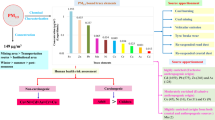Abstract
Particulate size distribution of PM10 and associated trace metal concentrations has been carried out in residential cum commercial area of Mahal at Nagpur city. Sampling for size fraction of particulate matter was performed during winter season using eight-stage cascade impactor with a pre-separator and toxic metals were analyzed using inductively coupled plasma-optical emission spectroscopy (ICP-OES). The average concentration of PM10 and fine particulate matter (effective cut of aerodynamic diameter ≤2.2 μm) was found to be 300 and 136.7 μg/m3, respectively which was exceeding limit of Central Pollution Control Board. Maximum mass concentration of 41 μg/m3 in size range of 9.0–10.0 μm and minimum mass concentration of 19 μg/m3 in size range 2.2–3.3 μm was observed. Metals (Sr, Ni and Zn) were found to large proportions in below 0.7 μm particle size and could therefore pass directly into the alveoli region of human respiratory system. Factor analysis results indicated combustion and vehicular emission as the dominant source in fine mode and resuspended dust was dominant in medium mode while crustal along with vehicular source was major in coarse mode of particulate matter.





Similar content being viewed by others
References
Allen AG, Nemitz E, Shi JP, Harrison RM, Greenwood JC (2001) Size distributions of trace metals in atmospheric aerosols in the United Kingdom. Atmos Environ 35:4581–4591
Balchandran S, Meena BR, Khillare PS (2000) Particle size distribution and its elemental composition in the ambient air of Delhi. Environ Int 26:49–54
Cabada JC, Rees S, Takahama S, Khlystov A, Pandis SN, Cliff I, Davidson CI, Robinson AL (2004) Mass size distributions and size resolved chemical composition of fine particulate matter at the Pittsburgh supersite. Atmos Environ 38:3127–3141
Chelani AB, Gajghate DG, Chalapati Rao CV, Devotta S (2010) Particle size distribution in ambient air of Delhi and its statistical analysis. Bull Environ Contam Toxicol 85:22–27
Furimsky E (2000) Characterization of trace element emissions from coal combustion by equilibrium calculations. Fuel Process Tech 63:29–44
Gietl J, Klemm O (2009) Source identification of size-segregated aerosol in Münster, Germany, by factor analysis. Aero Sci and Tech 43:828–837
Gokhale SB, Patil RS (2004) Size distribution of aerosols (PM10) and lead (Pb) near traffic intersections in Mumbai (India). Environ Monit Assess 95:311–324
Han JS, Moon KJ, Lee SJ, Kim YJ, Ryu SY, Cliff SS, Yi SM (2006) Size-resolved source apportionment of ambient particles by positive matrix factorization at Gosan background site in East Asia. Atoms Chem Phys 6:211–223
Harrison RM (1986) In: RM Harrison, Perry R (eds) Handbook of air pollution analysis. Champman and Hall, London, p 215
Horvath H, Kasahara M, Pesava P (1996) The size distribution and composition of the atmospheric aerosol at a rural and nearby urban location. J Aerosol Sci 27:417–435
ISO (1995) Air quality-particle size fraction definitions for health related samplings, 1st edn. International Organization for Standardization, ISO 7708, ISO Publications
Krzemińska-Flowers M, Bem H, Górecka H (2006) Trace metals concentration in size-fractioned urban air particulate matter in Łódź, Poland. I. Seasonal and site fluctuations. Pol J Environ Stud 15:759–767
Kulshrestha UC, Saxena A, Kumar N, Kumari KM, Srivastava SS (1998) Chemical composition and association of size-differentiated aerosols at a suburban site in a semi-arid tract of India. J Atmos Chem 29:109–118
Mishra UC (1988) Studies in aerosol size distribution and composition. J Aerosol Sci 19:1165–1169
Mohn J, Figi R, Graf P, Gujer E., Haag R, Honegger P, Mattrel P, Nagel O, Schmid P, Seiler C, Schreiner C, Steinhauser E, Zennegg M, Emmenegger L (2002) Wood combustion—clean energy? In: proceedings of 5th international conference on emission monitoring, Odense, Denmark, September 2002
Sharma VK, Patil RS (1992) Size distribution of atmospheric aerosols and their source identification using factor analysis in Bombay, India. Atmos Environ 26:135–141
Srivastava A, Jain VK (2007) Size distribution and source identification of total suspended particulate matter and associated heavy metals in the urban atmosphere of Delhi. Chemosphere 68:579–589
Stevens J (1996) Applied multivariate statistics for the behavioral sciences, 3rd edn. Mahwah, Erlbaum
Westerlund KG (2001) Metal emissions from Stockholm traffic-wear of brake linings. The Stockholm Environment and Health Protection Administration, 100 64, Stockholm, Sweden
Yadav S, Rajamani V (2006) Air quality and trace metal chemistry of different size fractions of aerosols in N-NW India—implications for source diversity. Atmos Environ 40:698–712
Acknowledgments
Authors deeply acknowledge CSIR, New Delhi for providing financial support in the form of senior research fellowship to Pradeep Pipalatkar for carried out research work. Authors are thankful to Director, NEERI, Nagpur for encouragement and permission to publish the paper. This work is also carried out under network projects NWP-045 on ‘‘Advancement in Metrology’’ and SIP 16 (2.2) is greatly acknowledged.
Author information
Authors and Affiliations
Corresponding author
Rights and permissions
About this article
Cite this article
Pipalatkar, P.P., Gajghate, D.G. & Khaparde, V.V. Source Identification of Different Size Fraction of PM10 Using Factor Analysis at Residential cum Commercial Area of Nagpur City. Bull Environ Contam Toxicol 88, 260–264 (2012). https://doi.org/10.1007/s00128-011-0445-2
Received:
Accepted:
Published:
Issue Date:
DOI: https://doi.org/10.1007/s00128-011-0445-2




